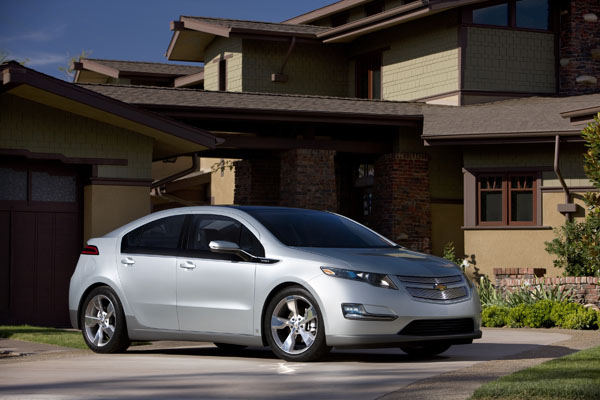2011 Chevrolet Volt (Photo: Courtesy GM)
Many of President Obama’s progressive supports have soured on him in recent months, as the debt crisis and a Republican House has forced him to embrace deep spending cuts, and environmentalists are among them. There’s still unhappiness among greens over the White House’s perceived failure to push hard for carbon cap-and-trade legislation—legislation that was a major campaign promise in 2008—and over the past year or so it seems as if the term “climate change” itself has disappeared from Obama’s rhetoric. Former Vice President Al Gore, who endorsed Obama in 2008 over Hillary Clinton, even took to the pages of Rolling Stone to gently criticize the President for failing to act on global warming.
But behind the scenes—and away from Congress—the Obama Administration has managed to make meaningful progress on energy and the environment, from tighter air pollution regulations from the Environmental Protection Agency to innovative ideas on clean tech research from the Department of Energy.
More from TIME: How Green Is Obama?
You can score another quiet green victory for the White House. Today the President announced a deal with automobile manufacturers to tighten fuel efficiency standards on cars and trucks in the near future. The agreement will raise the Corporate Average Fuel Efficiency (CAFE) standards to 54.5 mpg by 2025, up from 28.3 mpg now and 35.5 mpg in 2016. That new limit could eventually reduce greenhouse gas pollution from vehicles by about 50%, while reducing fuel consumption by 40%. Over time—especially if gas prices rises over the long-term, which many experts expect—the new rules will save drivers cash as well.
Here’s what President Obama had to say at a White House announcement this morning, flanked by CEOs from the major auto companies:
This agreement on fuel standards represents the single-most important step we’ve ever taken as a nation to reduce our dependence on foreign oil.
More from TIME: Will Israel’s Electric Cars Change the World?
This is actually the second time the White House has managed to increase CAFE standards, following up a 2009 agreement that focused on model years 2012 to 2016. But the new deal proved a harder bargain—back in 2009, General Motors and Chrysler were about to fall into bankruptcy, Ford was on the ropes and even foreign automakers were struggling in the wake of the recession. With a government bailout in the offing—and the memory of unsold SUVs still fresh from the days $4 a gallon gas in 2008—automakers had little choice but to play nice with the White House.
This time around, though, automakers threw up more resistance, complaining that the tougher goals demanded by environmentalists—who wanted to see a 60 mpg CAFE average—would raise the cost of vehicles by thousands of dollars and make heavier trucks and SUVs unsellable. It’s true that it will cost manufacturers more as fuel efficiency standards tighten, and that those costs will almost certainly be passed onto consumers. The 2009 deal will cost the industry more than $50 billion, and the National Highway Travel and Safety Administration has estimated that increasing fuel efficiency standard by about 5% annually, which the new deal will eventually do, will boost the cost of an average vehicle by at least $2,100.
Video from TIME: Can the Volt Power GM to Profitability?
The final deal, though, isn’t quite as tough as it looks. The Obama Administration has originally pushed for a 56 mpg standard by 2025 before backing down in the face of industry opposition. Light trucks—popular with consumers, but usually inefficient at the gas pump—will see fuel efficiency standards rise at a slower pace than cars will be required to meet. And many of the fuel efficiency standards will be met with simple technologies, including direct fuel injection, lighter weight materials and stop/start systems that automatically shuts the engines off during idling periods.
The national deal will also head off any independent effort by California—which is able to set its own fuel efficiency levels under the Clean Air Act, pending a federal waiver—to set tougher standards, which could have forced manufacturers to meet a patchwork of regulations around the country. That left some environmentalists—like the Safe Climate Campaign—complaining that the White House had given into corporate pressure.
Still, even though it was a compromise, environmentalists hailed today’s announcement, as Roland Hwang of the Natural Resources Defense Council put it:
With this standard everybody wins—not only drivers and auto workers but every man, woman and child who will be able to breathe cleaner air. Of course, the technology exists to cut even more carbon pollution and save even more oil in the future. The Environmental Protection Agency, the Transportation Department, and California are committed to review progress in several years, and we will keep working for stronger standards that cut more pollution and save consumers even more money.
With the debt ceiling crisis headed down to the wire, today’s CAFE announcement likely won’t get the attention it should. But Obama and his team deserve credit for pushing American cars—and the companies that make them—to get more and more efficient, to cut waste that we simply can’t afford. It’s the kind of far-reaching policy that will have positive impacts—for the environment and for the economy too, as Americans grapple with high energy costs—long after we’ve forgotten today’s drama in D.C.
Assuming, of course, the world doesn’t end on August 3.
More from Ecocentric: The Real Price of Gasoline
Bryan Walsh is a reporter at TIME. Find him on Twitter at @bryanrwalsh. You can also continue the discussion on TIME’s Facebook page and on Twitter at @TIME.


